Team-BHP
(
https://www.team-bhp.com/forum/)
Stratolaunch Systems was founded in 2011 by Paul G. Allen who has also co-founded Microsoft. The main objective was to develop an air launch platform which would make access to space more convenient. By easing the access to Low Earth Orbit (LEO), commercial, governmental and philanthropic organizations would be helpful for advancements in research and technology. This would basically also provide cost advantages to the air-launch customers. The first renderings of Stratolaunch carrier, which was pegged as the world's largest airplane were released last year.
Stratolaunch Systems has gone in partnership with Orbital ATK who will initially provide multiple Pegasus XL air-launch vehicles to launch small satellites into the low Earth orbit. Pegasus has previously carried out 42 space launch missions and placed over 80 satellites for scientific, commercial and defence purposes:

In 2011, Stratolaunch Systems leased out 81,000 square metres (20 acres) at the Mojave Air and Space Port, California to build production and launch facilities of the Stratolaunch aircraft. On May 31, 2017 the aircraft was finally moved out of the hangar which indicates the completion of the initial construction phase and the beginning of ground and flight testing phase.
Quote:
Over the past few weeks, we have removed the fabrication infrastructure, including the three-story scaffolding surrounding the aircraft, and rested the aircraft’s full weight on its 28 wheels for the first time. This was a crucial step in preparing the aircraft for ground testing, engine runs, taxi tests, and ultimately first flight - Jean Floyd, Chief Executive Officer, Stratolaunch Systems Corporation.
|
Talking about figures, the aircraft weighs approximately 5,00,000 lbs (2,26,796 Kilograms). It is designed for a maximum take-off weight of 1,300,000 lbs. (5,89,670 Kilograms), and is claimed to be capable of carrying payloads of up to 5,50,000 lbs (2,49,476 Kilograms). The plane is designed to launch rockets into the orbit from an altitude of 30,000 feet (9,100 metres). In initial stages, the plane will carry a single Pegasus XL rocket built by Orbital ATK and eventually it is expected to carry up to three of those simultaneously. One of the major advantages would be the minimization of constraints due to weather and range.
The aircraft is powered by six Pratt & Whitney PW4000 jet engines which are sourced from 2 used 747-400s. This is claimed to provide a reusable platform which will make the aircraft capable of frequent flights and airport style operations. The expected range is 2,200 km:

The wingspan is 385 ft. (117 metres). The National Football League (NFL) field spans 360 ft:

The aircraft measures 238 ft. (72.5 metres) from nose to tail:

It has a height of 50 ft. (15 metres) from ground to the top of vertical tail. The right fuselage is meant for the flight crew and the left fuselage houses flight data systems:

Here's a video showing the concept and the first look at the aircraft:
https://www.youtube.com/watch?v=BEHIv08Eh_8
The first launch demonstration is expected in 2019.

Source:
Stratolaunch and
Wikipedia
Quote:
Originally Posted by Omkar
(Post 4211102)
Talking about figures, the aircraft weighs approximately 5,00,000 lbs (2,26,796 Kilograms). It is designed for a maximum take-off weight of 1,300,000 lbs. (5,89,670 Kilograms), and is claimed to be capable of carrying payloads of up to 5,50,000 lbs (2,49,476 Kilograms). The plane is designed to launch rockets into the orbit from an altitude of 30,000 feet (9,100 metres). In initial stages, the plane will carry a single Pegasus XL rocket built by Orbital ATK and eventually it is expected to carry up to three of those simultaneously. One of the major advantages would be the minimization of constraints due to weather and range.
The aircraft is powered by six Pratt & Whitney PW4000 jet engines which are sourced from 2 used 747-400s. This is claimed to provide a reusable platform which will make the aircraft capable of frequent flights and airport style operations. The expected range is 2,200 km:
|
Thank you for sharing this. What a behemoth. I can't even imagine what skill will be needed to fly this bird. Technologically speaking there is no reason for it not to succeed.

For the curiosity of Team BHP readers interestingly the concept of a mother aircraft launching another was first tried out by the British in 1938. Photo below of mother sea plane Maia carrying the fast mail plane Mercury. Maia would get aloft to 10,000' and the release Mercury this helped save Mercury fuel burn on take off and climb and just about gave it the range to cross the Atlantic. While the concept trials were successful it did not get taken up commercially.
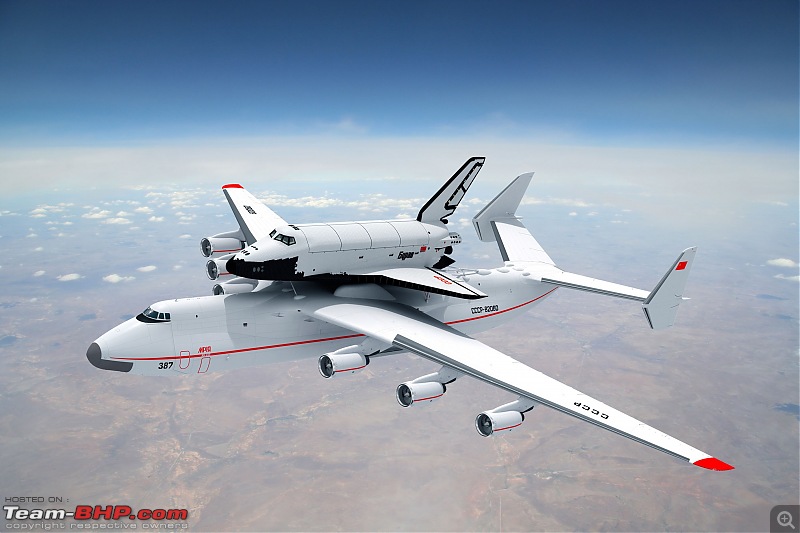
And then of course the Russians have their Buran carrier the Mriya An-225. In Soviet times for a couple of years it was used to transport he Russian shuttle to the cosmodrome.
The American shuttle too was transported to museums in a similar manner on top of modified Boeing 747.

Reusable launch vehicles might be the next big development in the space program. We saw SpaceX land its Falcon sometime back. It possibly conserves fuel, reduces space junk, keeps the weather window open, reduces dependence on a large area earmarked for launchpads, etc. This might also affect our own PSLV program for launching low earth orbit satellites. Hope our scientists are taking note of the disruption looming large on the Final Frontier.
Although the recent success of GSLV MK 3 is a grand and commendable achievement, the reusable rocket technology demonstrated by space X and the above said stratolaunch concept becoming a reality will push us back by at least a decade to catch up with the contemporary developing trends in technology.
Quote:
Originally Posted by smuniswami
(Post 4212123)
Although the recent success of GSLV MK 3 is a grand and commendable achievement, the reusable rocket technology demonstrated by space X and the above said stratolaunch concept becoming a reality will push us back by at least a decade to catch up with the contemporary developing trends in technology.
|
ISRO had already launched the first technology demonstrator of Reusable Launch Vehicle in May 2016. In this flight, critical technology such as autonomous navigation, guidance and control, reusable thermal protection system and re-entry mission management have been successfully validated.
The test was termed as Hypersonic Experiment 1 (HEX-1). The first test launch HEX1 is a preliminary step. Isro has to go a long way before it can be called a re-usable launch system.
Quote:
According to scientists, the indigenously made Reusable Launch Vehicle (RLV) is as a small step in achieving the objective of reducing the cost of space transportation and it may take 10-15 years for India to put in place such an operational rocket.
|
However India is already in the elite club of 'low cost' launches with high success rate!
Thanks to LoneRidder for adding value to my "post" by providing more information with respect to ISRO's achievements.
A ceiling of 30K feet seems low. While the benefits of not carrying rocket propellant for 30K feet of ascent from MSL (when air resistance and harmonic vibrations are more) is obvious, would it not make sense to go further up and reduce the overall propellant need? A larger payload + empty tanks topped by a KC-10 might work.
Any rocket scientists here?:D
Omkar thank you for starting this thread.
One of the wonderful things on T-BHP is the interest people show in subjects outside automobiles and the enthusiasm with which non-auto threads and posts are received. As this is a thread on the world's soon to be largest aircraft I am posting below photos and stories of some (not all) of the other aircraft that held this title in their times - some largest in take off weight, others in wing span or cubic volume and so on. The list is not exhaustive but contains some interesting characters from earlier times. I have not written on the well known planes such as the Airbus A380, Boeing 747, Lockheed C-5 Galaxy but written on the lesser known ones that were avian masters in their times. I have written from general knowledge - please feel free to add and correct. Have avoided one-off examples. For our readers the size of an aircraft is first determined by wing span (or rotor diameter) and then weight. Length is an offshoot of payload or role.
 1936 - Largest man made flying craft
1936 - Largest man made flying craft: The first post must go to the hydrogen filled German airship 'The Hindenburg'. At 245 metres (805 feet) in length and 200,000 cubic metres in volume it is by far the largest flying craft made by man. The hydrogen helped it float in air and four small 1200 hp diesel engines drove 4 props for forward or rearward movement. It carried 40 to 70 passengers in cruise liner comfort. Sadly it met a fiery end after 2 years of (then) record breaking trans-Atlantic crossings. The crossing from Germany to USA took 3 days.
 1934 Maxim Gorky
1934 Maxim Gorky: Before the Hindenburg the claim for largest aeroplane was shared by the Russian Tupolev ANT-20 land plane christened Maxim Gorky and the German Dornier Do X seaplane. Engines in the 1920s and 30s lacked power so several had to be tethered together to get to an acceptable power to weight ratio. The Maxim Gorky had 8 engines - 3 on each wing and 2 in a push-pull configuration on top of the fuselage! Incidentally its wing span of 63 metres remained the longest of a production aircraft till the famous Boeing 747 jumbo jet came in 1969
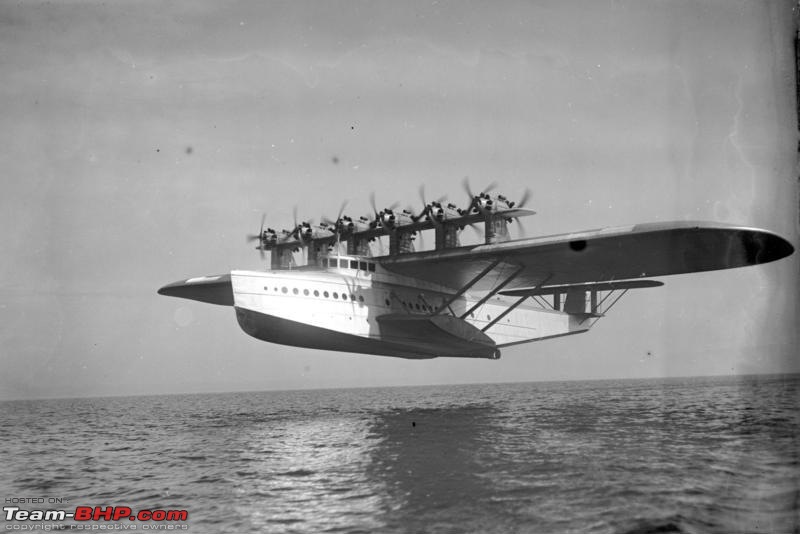 1929: The Dornier Do X
1929: The Dornier Do X. While the Maxim Gorky held the title of largest land plane and biggest wing span the German Do X had the highest ever take-off weight of 56,000 kgs. In 1929 that was an achievement. This lumbering flying boat cruised at 175 kmph (Jaguar and BMW owners please note). On one occasion during a flight when the pilots were having a tough time getting it to bank into a right turn they asked all the passengers to shift to the right and viola the big bird banked to starboard and turned! Its maximum take off weight record stood till the late 1940s.

It was powered by no less than twelve 600 hp piston engines! It need a 'engine control room' shown above to operate the engines. Like in a ship the pilot would send a telegraphic command to the engineer on power needed and then gradually a few tens of seconds later power would build up or down. Very different times.
 1940: Messerschmitt Me 323. First troop lifter.
1940: Messerschmitt Me 323. First troop lifter. - To transport troops and guns into Britain as a part of his invasion plan Hitler had this giant transport aircraft designed. Despite its ungainly looks about 200 were built and used extensively in WW-II. It was the first production transport where military vehicles could roll on and roll off. It carried two flight engineers seated one inside each wing between the inner and centre engines!! Poor flight engineers.It was a forerunner to modern military transports.

Its wings were so thick that a gunner could stand inside the wing and operate a defensive machine gun!
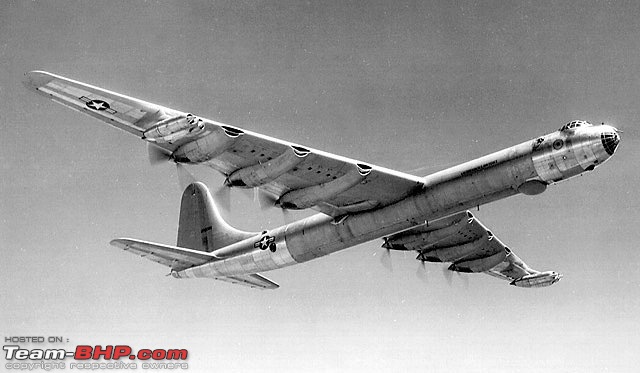 Convair B-36 - Heaviest bomber
Convair B-36 - Heaviest bomber. The first post war American strategic bomber. It holds four records all of which stand today 70 years later - (i)It is the largest piston engined production aircraft ever; (ii) the military aircraft with the longest wing span at 230 feet; (iii) the military aircraft to routinely carry the heaviest bomb load of 39 tonnes and (iv) the largest mixed propulsion aircraft ever to enter service. She was powered by 6 large 3800 hp Pratt & Whitney pistons and 4 GE turbojets each rated at 2350 kgp. 10 engines! Pilots on T-BHP will scratch their heads over the co-ordination of thrust needed to keep 10 engines flying in unison.
 1965: Antonov An-22 Heavy Lifter
1965: Antonov An-22 Heavy Lifter. The world's first true military heavy lifter, the world's heaviest propeller driven aircraft ever (at 250 tonnes) and till today world record holder for weight to altitude under the propeller powered category. Its 4 engines provide 60,000 shp. That is the sort of power you would find on a 6000 tonne missile armed warship. And the An-22 could take off and land on mud strips.
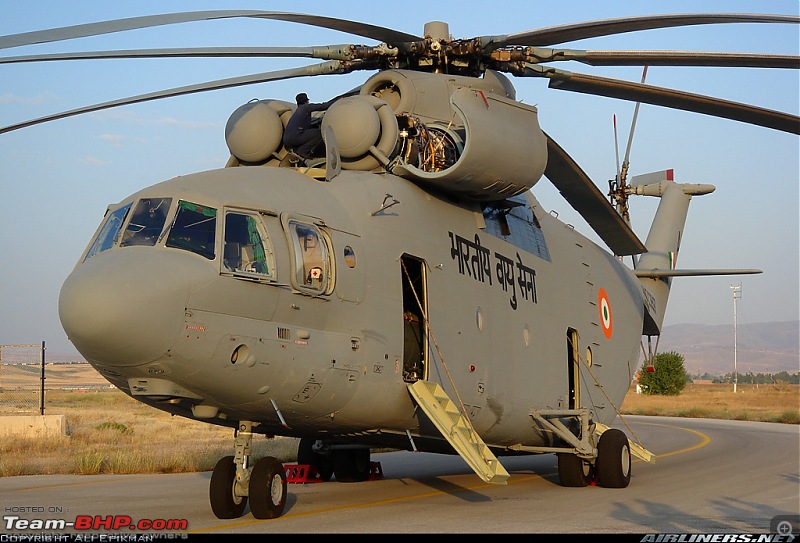 1983: Mil Mi-26 - largest helicopter -a marvel of engineering
1983: Mil Mi-26 - largest helicopter -a marvel of engineering. The largest production chopper ever and the second largest helicopter (production, prototype or experimental) ever to fly. Rotor diameter of 105 feet, engines 2 x 11,400 turboshafts, 56 tonne maximum take off weight, 20 tonnes of cargo. Over 300 have been built. A real credit to the aeronautical designers of the erstwhile USSR. To give you a visual reference -with a length of 131 feet with rotors turning it is in the size range of an Airbus A320 of Indigo airlines.

 1986: An-124 Ruslan. Largest cargo plane.
1986: An-124 Ruslan. Largest cargo plane. From 1986 to 2011 the heaviest cargo lifter in the world weighing in at 405 tonnes and a cargo capacity of a whopping 170 tonnes. Even today it remains the largest military cargo lifter. Is often seen at major Indian airports carrying carriages of the metro rails being built in most big cities.
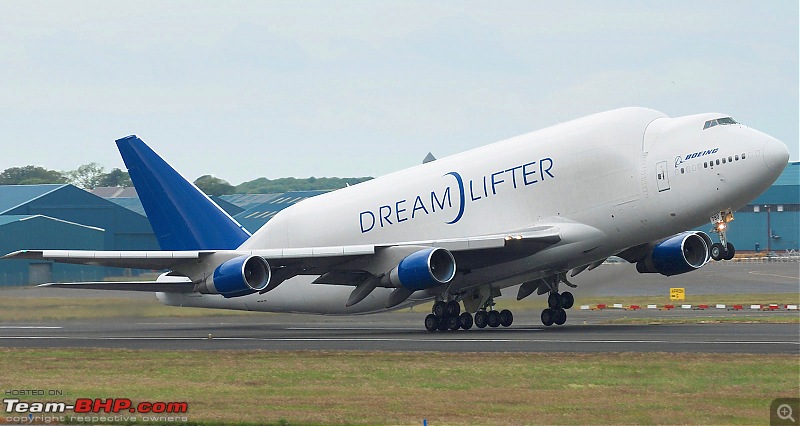
 Boeing 747-400L - Aircraft with the greatest internal cargo volume - all of 1800 cubic metres
Boeing 747-400L - Aircraft with the greatest internal cargo volume - all of 1800 cubic metres. A greatly modified Boeing 747. Used for transporting under production fuselages of the Boeing 787 between facilities. Airbus have a similar aircraft but smaller.
It is big for sure. Others have mentioned Shuttle carriers which are comparable in size.
In the bad, old Soviet Union, they designed bigger vehicles in the 50's.
It was dubbed the Caspian Sea Monster and used something called Ground Effect to skim the waves.
It was heavier. 500 tons vs this 300.
It was cheaper.
And oh yeah, it carried six nuclear missiles.
Here is one YouTube video:
https://www.youtube.com/watch?v=hVHBl37IuKw
World's largest plane, ever, flies for the first time
Stratolaunch, the world’s largest airplane ever took to the skies on its maiden flight, in California, on 13th April 2019. The size of a plane is measured in terms of wingspan, maximum take off weight and length in that order. At 117 metres its wingspan and a take off weight at 650 tonnes. Its closest competitor the Antonov An-225 has a maximum take off weight of 640 tonnes and a wing span of 88 metres.
The Stratolaunch aircraft is a giant flying launch pad, designed to hurtle satellites into low Earth orbit. Stratolaunch would carry a rocket loaded with a satellite on its centreline, will take off from Mojave and climb to an altitude of 35,000 feet. There, pilots will launch the rocket from the plane on a trajectory toward space. The plane then will land back while the rocket carries the satellite into an orbit ranging from about 500 kms to 2000 kms above Earth. The rocket deploys the satellite before eventually falling back to Earth, burning up in the sky like a meteor.
All photos from www.stratolaunch.com https://www.youtube.com/watch?v=VFHAz4AG-no
Stratolaunch, the private launch company founded by the late billionaire Paul Allen, has just flown the world's largest aircraft for the first time.
The massive airplane, which has a wingspan bigger than a football field and is designed to launch rockets from the air, took off on its maiden test flight from the Mojave Air and Space Port in Mojave, California, on April 13.
"We all know Paul would have been proud to witness today’s historic achievement,” his sister Jody Allen, chair of Vulcan Inc. and trustee of the Paul G. Allen Trust, said in a statement released by Stratolaunch today. "The aircraft is a remarkable engineering achievement, and we congratulate everyone involved.”
The flight, while not officially announced beforehand by Stratolaunch, was spotted by photographers at the airport, where the company has been conducting runway tests with the giant plane in recent months.
"It was surprising. In a way, I expected it to take longer," aerospace photographer Jack Beyer told Space.com after watching the plane's take off, adding that it almost felt anticlimactic. "And then I realized it was actually effortlessly in the air and was and was astounded."
https://www.space.com/stratolaunch-f...irst-time.html https://youtu.be/v5IahB6-Xxw
Mods : I could not find an appropriate thread, kindly do the needful, if required.
| All times are GMT +5.5. The time now is 05:45. | |























